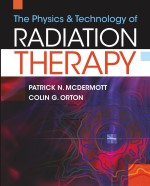
The Physics & Technology of Radiation Therapy
Author: Patrick McDermott and Colin OrtonISBN: 9781930524446
Published: 2010 | 856 pp. | Softcover
OUT OF PRINT
International Journal of Radiation Oncology Biology Physics, Vol. 80, No. 2 | 2011
This introduction to the physics and technology of radiation therapy developed from years of classroom lecture notes taken by radiation oncology residents is designed to take the reader from elementary mathematic concepts through the basic physics of radiation to applications in clinical medical physics. It presents a wide range of information in a simple yet concise manner, omitting detailed explanations for clarity but using clinical examples for emphasis.
The authors state that the book is for ‘‘the rest of the radiation therapy community’’—radiation technologists, dosimetrists, and radiation oncologists—so the text is suitable for radiation physics trainees and radiation oncology residents and represents a useful introductory self-study tool for physicists not trained in therapeutic radiation physics planning to enter this field.
The book is laid out in 20 chapters. Because radiation physics depends heavily on math, the book begins by reviewing mathematic principles, followed by basic physics and applied radiation therapy physics, and ending with novel treatment delivery modalities in the final chapter. Numeric examples are provided where necessary, with colored pictorial illustrations, and practice questions, chapter summaries, and bibliographic references are provided at the end of each chapter. Although the book does not cover treatment planning, it does cover most of the fundamental information relevant to radiation therapy practice. Radiation technologists with limited or no college math would benefit from the earlier chapters. Physics students and junior physicists would find the beginning chapters to be basic but would appreciate the later chapters. Radiation oncology residents would benefit from the entire book. An appendix is dedicated to technologists and radiation oncologists preparing for certification examinations and points them to the relevant book sections.
As the authors state in the preface, the book assumes that the majority of the readers are not expert in math or physics and shies away from mathematic equations. It achieves this at the expense of leaving the reader with many questions about the derivation of some of those equations. Thus, a more advanced physics or math reader may find that mathematic symbols used in the earlier chapters of the book are not defined. For example, it would be helpful to mention that dot (.) represents multiplication to avoid confusion with scalar product. Also, r is introduced as the exponent, but n appears on the equations as the exponent (e.g., equations 1.1 and 1.5). The authors define scalar and vector quantities in Chapter 2 and mention that arrows are used to represent a vector, but this convention is not followed consistently throughout the chapter. A few examples: in equation 2.2, V needs an arrow; in equation 2.6, g needs an arrow; and in equation 2.7, W and F need arrows.
Force plays an important role in describing the interaction between two bodies or particles (e.g., electrons interacting with atoms in the human body). The authors’ casual dismissal of a further definition of force in Chapter 2 is disappointing.
The authors have given gravitational acceleration a fixed value of 9.8 m/s2. They should have pointed out that this value varies with location and can affect quantities like atmospheric pressure, used in machine calibration. Equation 2.6 (weight = m x g) should have mentioned that g is gravitational acceleration, not just another constant value.
Chapter 3 presents radioactivity, including basic properties of nuclei, nuclear forces and transformations, radioactivity equations, heavy particles and particle accelerators, and commonly used radioactive materials and their half-lives. Decay processes, including positron emission and electron capture, are mentioned, though not in detail. A physician reader needs to understand the importance of these processes in brachytherapy, especially for 125I, which decays through electron capture only, vs. 103Pd, which decays through both processes.
In Chapter 4, to avoid confusion, it would be better to have used Vp for peak voltage rather than kVp. In Figure 6.4, Ey’ is not shown, and the figure caption is confusing. Chapter 8 discusses film dosimetry but does not mention radiochromic dosimetry, a topic of increased interest. It would also have helped to discuss the use of thermoluminescent dosimeters in detail for in vivo dosimetry and verification of external agency machine output calibration. The authors state that there exist only three linac manufacturers, whereas there are actually three major linac manufacturers. Also, although the text refers to a Mevalac machine, there exists no such linac or manufacturer.
This book represents a useful resource for technologists and radiation oncologists and a good starting point for junior physicists involved in radiation therapy. The text is more concise and often easier to understand than other books on radiation therapy physics, like, for example, Khan’s The Physics of Radiation Therapy, the leading physics reference text book in this field.
Dan Odero, Ph.D.
Raleigh Regional Cancer Center
Beckley, WV


